Country Homes
See How Florist Alison Westlake Decorates Her P.E.C Farmhouse For The Holidays
Updated on November 17, 2023
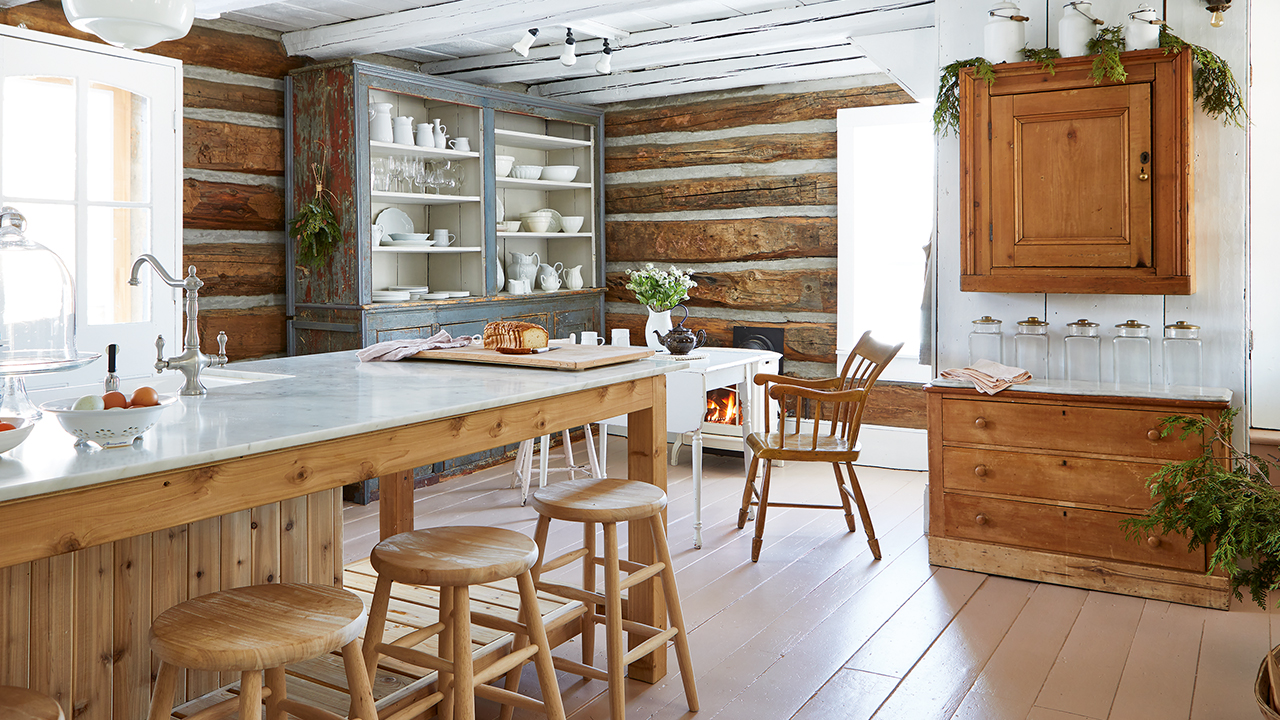
Farm life comes naturally to Alison Westlake, who grew up on one in Hastings County, Ont. “I call them my Anne of Green Gables years: angst-ridden, cursing at the sky and longing for the day when I could pack up and head for the big city,” says Alison. “But I discovered that when I was elbow-deep in dirt, I felt the most like myself.” In her early 20’s, the entrepreneur worked for a landscape design company, arranging flowers for friends and family on the side. That led to opening Coriander Girl (after her nickname, Coriander) in 2009, in Toronto’s Parkdale neighbourhood. “The original business model for the shop was actually more home decorating than floral, but BlogTO called us a ‘Top Florist’ and there was no going back!” she says.
In 2015, Alison moved from the city to Prince Edward County’s Sophiasburgh, just south of her childhood home. She’d had her first daughter and wanted to raise her the way she’d been raised, in a bucolic, small town setting. So she opened a new Coriander Girl shop nearby in Picton, Ont., and purchased a six-hectare farm to grow flowers to sell, but also to grow her business (she hopes to open an event venue here). “The property is one of the oldest in Ontario, and the perennial gardens are out of a Jane Austen novel,” says Alison. Nearly 50 per cent of the shop’s flowers — dahlias, zinnias, cosmos, snapdragons and sweet peas, to name a few — are grown on the acreage, which also boasts a historical farmhouse, where she lives with her two daughters, Hattie, 7, and Adeline, 4. “Prince Edward County is an incredible community to be a part of,” she says. “I’m seeing more young families and entrepreneurs here, and everyone wants to help each other.” Come early December, Alison begins her holiday decorating in a Scandi, farm-to-floral style.
Scroll down to see her cozy P.E.C farmhouse dressed for the holidays!
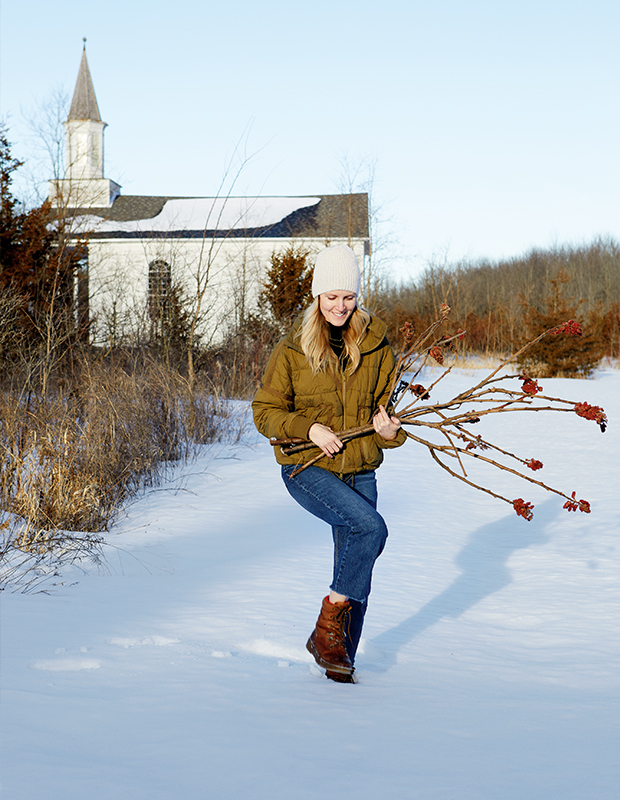
Alison forages for sumac branches on her farm, where she hopes to convert the 200-year-old church into a wedding and event venue. Hattie and Adeline are following in Mom’s footsteps. “I’ll set them up with snips and send them out into the garden to have at it,” says Alison. They forage for sumac pods, ornamental grasses and dried florals to decorate the house for the holidays.

A grapevine wreath on the dining room mantel creates a natural focal point. The upside-down bouquets are being dried to display around the house.
When Alison bought the 2,500-square-foot house, she indulged her love of interior design, painting the floors and walls in her go-to Benjamin Moore colors: Mascarpone, a creamy white, and Venetian Portico, a muddy, pastel rose.

The door of the 19th-century farmhouse is painted in a muddy pastel rose. “I like to keep things fairly minimal, using natural materials and a soft palette,” she says. The seven-bedroom, four-bathroom home, now named Coriander Country House, was moved to its current location from Cobourg, Ont., (where it once had another life as an inn) by the former owners. Every floorboard, baseboard, window frame and mantel was numbered so it could be put back together like a puzzle on top of a new foundation.
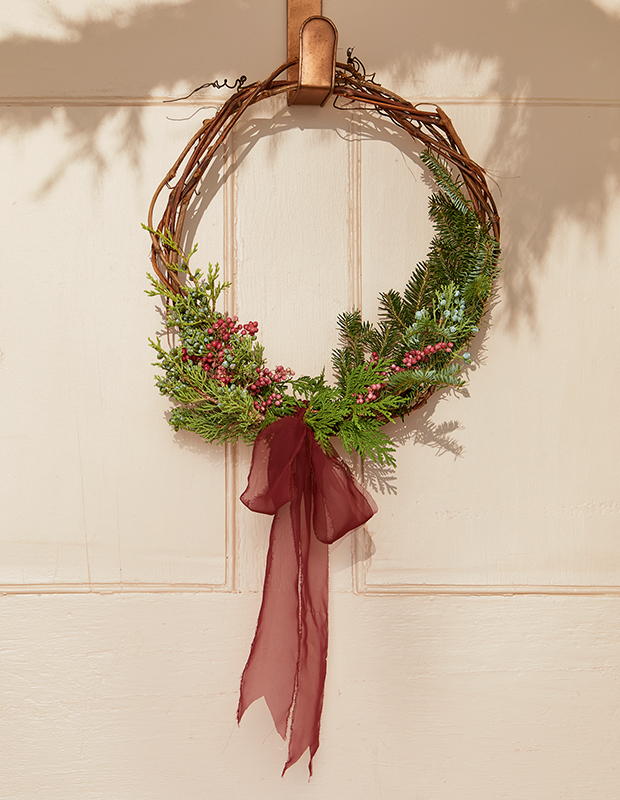
Asymmetrical Grapevine Wreath
Materials: 1 to 5 metres of grapevine, floral wire (optional), evergreen clippings, dried berries or florals, glue gun (optional), ribbon
1. Forage or purchase 1 to 5 metres of dried grapevine (the wreath, right, took 2 metres) to create a wreath form. The more vine, the thicker the wreath.
2. Twist and wrap the grapevine loosely together, bending to form an asymmetrical circle.
3. Wind the vines until you have the desired look and thickness, then intertwine the ends and secure with floral wire, if necessary.
4. Tuck evergreen clippings, such as pine, cedar and juniper, and a few sprigs of dried florals or berries into the bottom of the wreath. Use floral wire or a glue gun to secure, if necessary.
5. Tie on a ribbon and hang.

Adeline (left) and Hattie enjoy making crafts with their mom. Alison and her daughters kick off the season by decorating the tree, playing Christmas music and drinking eggnog. “It’s what my family did when I was little, so it’s completely nostalgic for me,” she says. For this florist who believes that home is a reflection of the heart, there’s nothing better than a cosy holiday spent with her girls at the farmhouse.

In the entry, Alison repaints the extra-wide front door and trim a new color every season; this year’s robin’s-egg blue is a foil for the checkerboard floor.

Evergreen Swag
Materials: Pruning shears, evergreen clippings, decorative florals, twine
1. Clip evergreen branches, such as cedar, pine and juniper, into 18 to 24″ lengths, and cut 12- to 18″-long pieces of decorative florals, such as dried pepper berry, bunny tail grass, Lunaria or poppy seed pods.
2. Lay the clippings down with the cut ends facing the same direction. Place the longest evergreen branches on the bottom and the shorter decorative pieces on top.
3. Cut a 20″-long piece of twine and wrap one end of the twine around the bundle 5 to 10 times tightly. Tie a knot.
4. Use the other end of the twine to hang the bundle, indoors or out. Mist the evergreens daily to keep them fresh.

Alison favours bright, neutral interiors with thoughtful moments of color (usually a moody pastel), and she loves to mix in antiques that proudly show their age. The dining room is her favorite space; she and the girls spend most of their time here crafting. The oversized hutch houses all the craft supplies.
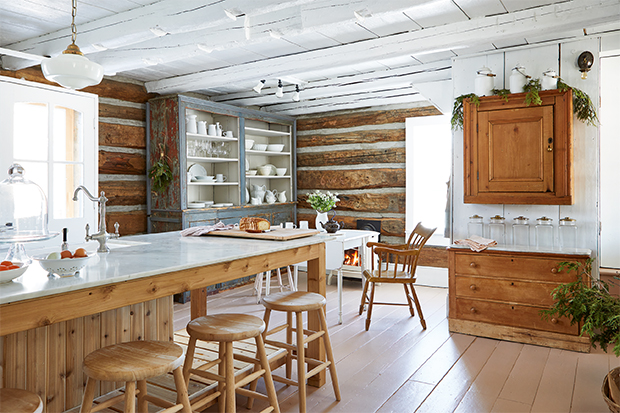
In the kitchen, Alison prefers antique pieces to traditional cabinets. “Often, I’ll just buy an antique piece knowing that, one day, I’ll find the perfect place for it. I don’t think there’s anything in the home that’s younger than 100 years old, other than me and the girls,” she says with a smile. Her dad built the giant cedar island.

A blue hutch is home to Alison’s collection of ironstone dishware.
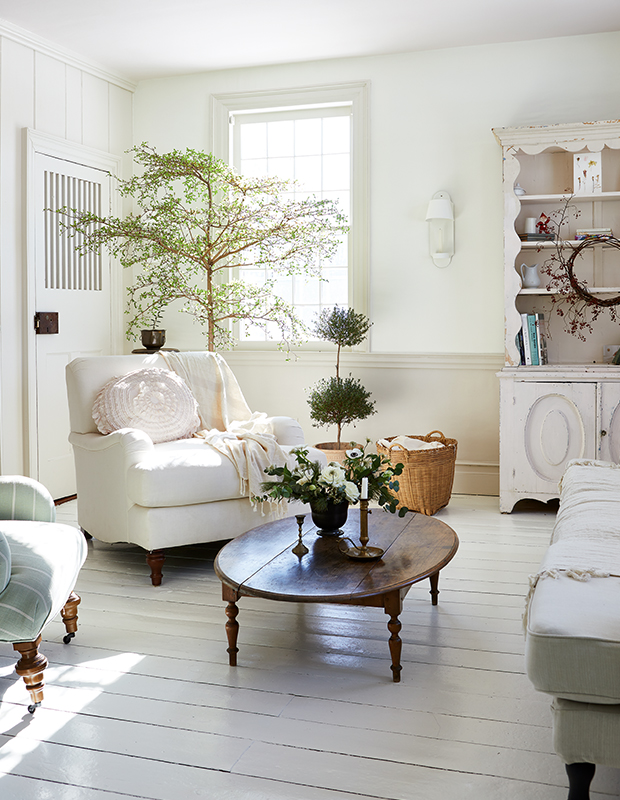
The mostly white living room glows during the late afternoon golden hours. “Every year, I say I’m going to go wild with color and more ornaments, but I always end up with some variation of this pared-back Scandi style,” she says. Bare trees are sprinkled throughout the farmhouse, and spruce, cedar and juniper boughs and swags are natural — and fragrant — festive touches.

Alison decorates the Christmas tree in her parlor with vintage ornaments, pastel ribbons, twinkle lights and a dried orange slice garland.
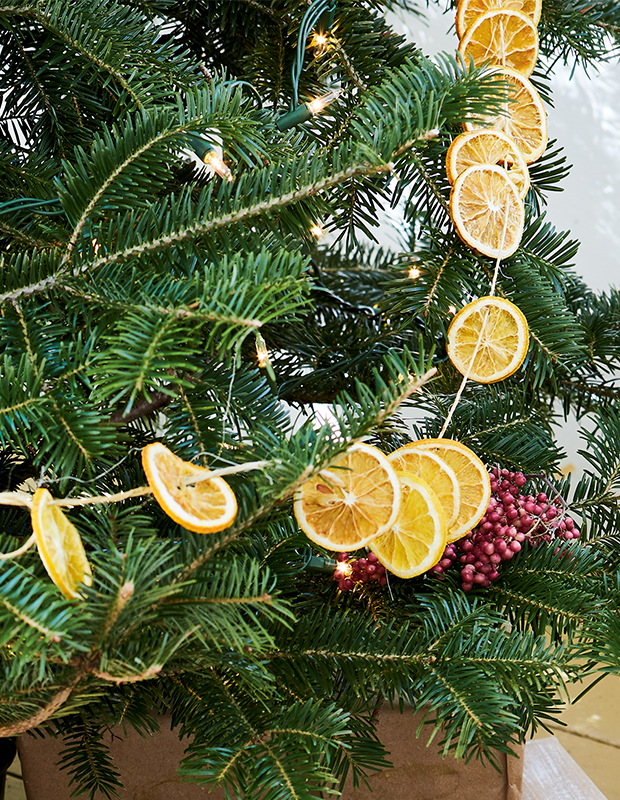
Dried Orange Slice Garland
Materials: Baking sheet, parchment paper, 10 to 15 oranges, serrated knife, paper towel, scissors, twine
1. Preheat the oven to 200°F and line a baking sheet with parchment paper.
2. Cut oranges into ⅛”-thick slices using a sharp serrated knife, and gently pat slices dry with a paper towel to remove any excess juice.
3. Place the slices in a single layer on a baking sheet and bake for about 2 hours, flipping every 30 minutes.
4. Once cool, use scissors to poke a small hole through each slice.
5. Thread the slices onto a 10- to 15′-long piece of twine, leaving space between them, then hang on your holiday tree or mantel.

Brushstroke Gift Wrap with Foraged Accents
Materials: Kraft paper, tape, paintbrush, paint, paper towel, twine, dried florals
1. Tape kraft wrapping paper onto a flat surface.
2. Dip the tip of a paintbrush into white paint, then blot the paintbrush with a paper towel so the brush is fairly dry.
3. Gently drag the paintbrush over the paper, creating uneven brushstrokes so the pattern looks handmade and not perfectly uniform.
4. Allow to dry, then wrap up your gifts, tying packages with twine and tucking in sprigs of dried florals such as hydrangeas or thistles.

The pared-back girls’ bedroom brings together painted Jenny Lind bed frames, wintry white walls and wooden antique pieces.

This original Rumford fireplace is one of five in the house.

Alison dresses up bare winter branches with homemade ice ornaments.

Ice Suncatchers
Materials: Dried foraged finds, shallow container, water, twine
1. Forage outside for dried blooms, such as hydrangea, seed heads and pinecones.
2. Fill a shallow container (takeout containers work well) with 1 to 2″ of water and immerse the foraged finds.
3. Cut a piece of twine to your desired length and submerge one end in the water.
4. Put the container in the freezer or outside, if temperatures are below 0°C.
5. Once the suncatcher is frozen, gently remove it from the container and suspend from a tree branch outdoors.

Alison has six ducks on the farm named Primrose, Thorn, Lilac, Tulip, Burdock and Rosebud. “They make me feel like we’re living in a Beatrix Potter book,” she says.
Valerie Wilcox
House & Home November 2021


